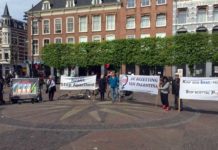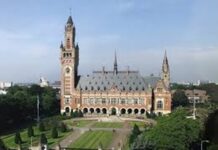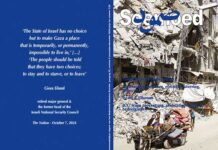OCHA / September 25, 2024
Since 7 October 2023, the Israeli authorities have imposed additional restrictions on the movement of 3.3 million Palestinians across the West Bank, including East Jerusalem, in the form of physical obstacles or restricted access regulations. A rapid survey conducted by OCHA in March 2024 found that 86 new movement obstacles were set up in the West Bank since October 2023. In addition, there were changes documented in relation to the status of about 100 pre-existing obstacles that entailed tighter restrictions, such as the closure of road gates that were previously usually open or through limiting opening hours of some checkpoints. Coupled with the 712-kilometre-long Barrier, which remains the single largest obstacle in the West Bank, movement obstacles control, restrict and disrupt the freedom of movement of Palestinians either permanently or intermittently, further entrenching territorial and social fragmentation, undermining livelihoods, hindering access to basic services, and contributing to worsening humanitarian conditions.
At present, there are 793 movement obstacles which are permanently or intermittently controlling, restricting and monitoring Palestinian movement in the West Bank, including East Jerusalem and the H2 area of Hebron. OCHA has documented these obstacles, which include 89 checkpoints staffed 24/7; 149 partial checkpoints that are not always staffed (46 of which have gates); 158 earth-mounds; 196 road gates (122 of which are usually closed); 104 road blocks; and 97 linear closures each of which blocks one or more roads, such as road barriers, earth-walls and trenches. OCHA’s last closure survey in June 2023 documented 642 obstacles. Sixty-five new obstacles were subsequently documented before October 2023, bringing the total number of obstacles to 707. Between October 2023 and March 2024, OCHA documented 86 additional obstacles, of which 37 are in the central West Bank, 30 in the northern West Bank and 19 in the southern West Bank. This constitutes a 23 per cent increase over nine months (793 vs. 642). Sixty-five per cent of the new obstacles since October 2023 are earth-mounds and partial checkpoints. Of the total number of obstacles, 26 per cent are in Hebron governorate, 18 per cent in Ramallah governorate, and 16 per cent in Nablus governorate.
At least 40 per cent (316 out of 793) of movement obstacles prevent direct access between Palestinian towns and villages and eight major roads that run through the West Bank, where there is an average of nearly one closure per kilometre. These obstacles funnel Palestinian traffic onto longer, secondary road networks, disrupting the movement of hundreds of thousands of Palestinians and adversely affecting their access to emergency services. One of these key routes is Road 60, the major north- south traffic artery in the West Bank, where at least 129 movement obstacles are located along 180 kilometres within the road’s 300-metre buffer. Another key route is Road 505, the east- west route that connects the Jordan Valley with the northern West Bank, where 61 closures are located along 57 kilometres.
85 per cent of the Separation Barrier runs inside the West Bank, hindering access from/to East Jerusalem and the so- called “Seam Zone” areas located between the Barrier and the 1949 Armistice Line. Thirteen checkpoints along the Barrier continue to separate East Jerusalem from the rest of the West Bank, only three of which can be used by Palestinians who hold West Bank IDs and Israeli-issued permits, which are difficult to obtain. Most of these permits have been revoked or suspended since 7 October, including more than 800 permits that had been issued for nationally recruited humanitarian workers. According to the World Health Organization (WHO), between October 2023 and August 2024, 44 per cent of the 46,163 applications for medical care in East Jerusalem and Israeli health facilities, were either denied or remain pending. Access to agricultural land has also been impacted; 150 communities who own land isolated by the Barrier and to which access was previously regulated by Israeli forces through 69 agricultural gates have been generally barred from working their lands since October 2023, leading to significant income losses, especially from olive groves and other seasonal crops. In addition, about 1,500 Palestinians with West Bank IDs who live in 18 communities on the East Jerusalem side of the Barrier continue to face impediments in travelling between their homes and service centres; they are forbidden from reaching East Jerusalem and are forced to coordinate their access with Israeli forces to cross checkpoints to access basic health and education services as well as markets on the West Bank side of the Barrier.
One third of the land on the outskirts of 56 Israeli settlements is privately owned by Palestinian communities and require “prior coordination” with the Israeli military to facilitate owners’ access to their land at designated times twice a year. This negatively affects 105 Palestinian communities across seven governorates, including: 28 in Nablus, 20 in Qalqilya, 15 in Bethlehem, 12 in Hebron, 12 in Ramallah, 10 in Salfit and eight in Tulkarm. Much of this land has been declared by the Israeli authorities a “closed military zone” and may only be accessed by Palestinian farmers through special authorization by the Israeli authorities, which was previously granted for a limited number of days a year, including during the olive harvest and ploughing seasons. Since 7 October 2023, the Israeli authorities discontinued this coordination mechanism, rendering these areas inaccessible to Palestinians.
More than 1,400 access incidents were documented by OCHA between 7 October 2023 and 31 July 2024, which entailed access prevention or delays by the Israeli army mainly due to the temporary closure of checkpoints and road gates (over 300 incidents), the installation of mobile or “flying” checkpoints (380 incidents), or the staffing of partial checkpoints by Israeli forces (760 incidents). Checkpoints as a central component of the closure regime in the West Bank, including East Jerusalem, are also hotspots of confrontations between Israeli forces and Palestinians and where Palestinians are regularly detained. Since 7 October, at least 580 cases of detention were documented that occurred within the context of access incidents. Furthermore, access to emergency services, such as ambulances and fire brigades, has been impeded due to increased restrictions. According to WHO, the number of health-related access incidents that entail obstructions of access by ambulances, mobile clinics, and first aid responders has more than doubled in the period between October 2023 and July 2024 compared with the preceding nine months (387 vs. 138 incidents). Other types of attacks include detention of health workers and patients and militarized searches of ambulances, among others.
Under international law, the Israeli authorities have the obligation to facilitate the free movement of Palestinians within the Occupied Palestinian Territory. Exceptions to this obligation are recognized only for imperative reasons of security and only in response to specific security threats. The sections of the Barrier running inside the West Bank, together with the associated gate and permit regime, are unlawful under international law (see the International Court of Justice’s advisory opinion on the Legal Consequences of the Construction of a Wall in the Occupied Palestinian Territory, 9 July 2004).
The closures, along with heavy presence of Israeli forces and armed settlers on roads, have resulted in significant movement restrictions for Palestinians, hindering their ability to access markets, workplaces, emergency services, as well as health and educational facilities. In most cases, these movement restrictions do not typically apply to Israeli settlers. The UN Human Rights Office has noted that movement restrictions appear both arbitrary and discriminatory against Palestinians, raising concerns of collective punishment (see the UN Human Rights Office’s Flash report on the human rights situation in the West Bank including East Jerusalem, 7 October – 20 November 2023).
Nablus governorate which has a population of 439,000 people (PCBS 2024 population projections) has about 128 movement obstacles, including inter alia 32 occasionally staffed checkpoints and nine constantly staffed checkpoints around Nablus city, the primary service centre for health care, education and employment for about 1.3 million people living in six governorates in the northern West Bank. Two checkpoints (Huwwara-Awarta junction and Samaritan community) are closed to Palestinians but are used by Israeli settlers and forces, while frequent vehicular searches, ID checks and temporary closures at the other seven checkpoints often result in significant delays or force people to take long detours. Among the affected are thousands of patients seeking reliable access to the two main hospitals in Nablus city, An Najah and Rafidia, and approximately 110,000 school students and 6,000 teachers who need to reach their educational institutions, according to the Ministry of Education. Economic activity was similarly affected; according to the Nablus Chamber of Commerce, the tourism and hotel sectors have shut down and have only recently resumed operations at a small fraction of their capacity, trade transactions have shrunk by at least 60 per cent, and about 20 per cent of goods transported into and out of the city are damaged due to long waiting hours at checkpoints.
Nearly a third of checkpoints (28 out of 89) and roughly 10 per cent of physical obstacles (80 out of 793) in the West Bank are located in the H2 area of Hebron City, which comprises about 20 per cent of Hebron city and where Israel exercises direct control. The part of H2 subject to strict movement regulations is currently home to about 7,000 Palestinians and several hundred Israeli settlers. Between 7 and 22 October 2023, the area was placed under full closure, applicable only for the Palestinian residents, after which a new system of entry and exit was introduced that continued to bar non-registered Palestinian residents from accessing the area, except on Fridays during the month of Ramdan, and where the movement of Palestinian residents was generally permitted only between 7:00 and 19:00. Three Palestinian schools in the area serving at least 350 students remained closed for nearly seven months, until 1 May 2024 when Israeli authorities allowed Palestinian teachers and students to gain access to the area. The only primary healthcare clinic was similarly closed for about seven months before it resumed partial operations. This has gravely affected the ability of residents to seek medical care, particularly people suffering from chronic illnesses and about 50 persons with disability who depend on the clinic for free services and medications. Strict access regulations have also jeopardized access to emergency care as emergency health services and ambulances need to coordinate with Israeli forces to access the area.
In Tulkarm governorate, Deir al Ghusoun, Attil and Zeita towns (pop. 26,000, PCBS 2024 population projections) – known as “Deir al-Ghusun cluster” – are among the towns and villages that were denied access to their agricultural land located behind the Barrier for the past 10 months. Prior to October 2023, the families had daily access via agricultural gates to their lands in the so- called “Seam Zone”, between the Barrier and the Green Line, following coordination with the Israeli authorities. The 100 dunums (25 acres) of land owned by the three towns mainly comprise greenhouses and are planted with a variety of crops, including cucumbers, tomatoes, beans, zucchinis, eggplants, bell peppers, and chili peppers. The loss of access to these lands has resulted in significant income losses for the families, severely disrupted the fresh food supply on local markets, and undermined land productivity. According to the Palestinian Ministry of Agriculture, the annual losses of the three villages in Deir al-Ghussun cluster due to the lack of agricultural access are estimated at around US$1.4 million.












